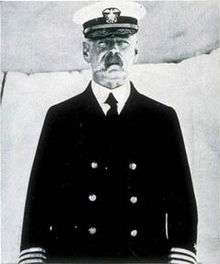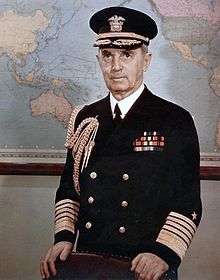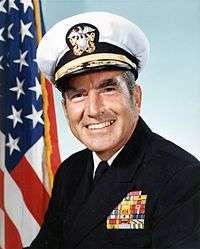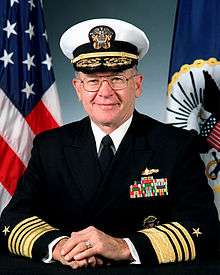Chief of Naval Operations
| Chief of Naval Operations
CNO | |
|---|---|
|
Seal of the Chief of Naval Operations | |
|
Flag of the Chief of Naval Operations | |
| Department of the Navy | |
| Member of | Joint Chiefs of Staff |
| Reports to |
Secretary of Defense Secretary of the Navy |
| Appointer |
The President with Senate advice and consent |
| Term length |
4 years Renewable |
| Constituting instrument | 10 U.S.C. § 5033 |
| Formation | 11 May 1915 |
| First holder | ADM William S. Benson |
| Deputy | Vice Chief of Naval Operations |
| Website | Official Website |
The Chief of Naval Operations (CNO) is a statutory office (10 U.S.C. § 5033) held by a four-star admiral in the United States Navy, and is the most senior naval officer assigned to serve in the Department of the Navy. The office is a military adviser and deputy to the Secretary of the Navy. In a separate capacity as a member of the Joint Chiefs of Staff (10 U.S.C. § 151) the CNO is a military adviser to the National Security Council, the Homeland Security Council, the Secretary of Defense, and the President. The current Chief of Naval Operations is Admiral John M. Richardson.
The Chief of Naval Operations is an administrative position based in the Pentagon, and while the CNO does not have operational command authority over Naval forces as the title implies (that is nowadays within the purview of the Combatant Commanders who report to the Secretary of Defense), the CNO does exercise supervision of Navy organizations as the designee of the Secretary of the Navy.
Responsibilities
Department of the Navy
The CNO reports directly to the Secretary of the Navy for the command, utilization of resources, and operating efficiency of the operating forces of the Navy and of the Navy shore activities assigned by the Secretary.[1] Under the authority of the Secretary of the Navy, the CNO also designates naval personnel and naval resources to the commanders of Unified Combatant Commands.[2][3] The CNO also performs all other functions prescribed under 10 U.S.C. § 5033 and those assigned by the secretary[2] or delegates those duties and responsibilities to other officers in his administration. The CNO is typically the highest-ranking officer on active duty in the Navy unless the Chairman and/or the Vice Chairman of the Joint Chiefs of Staff are naval officers. Like the other joint chiefs, the CNO is an administrative position and has no operational command authority over United States naval forces.[1]
Office of the Chief of Naval Operations
The Chief of Naval Operations presides over the Office of the Chief of Naval Operations (OpNav),[4] which is one of three headquarters staffs in Department of the Navy (the others being the Office of the Secretary of the Navy and Headquarters Marine Corps.)
Policy documents are issued in the form of OPNAV Instructions.
Appointment
The Chief of Naval Operations is nominated by the President for appointment and must be confirmed by the Senate.[5] A requirement for being Chief of Naval Operations is having significant experience in joint duty assignments, which includes at least one full tour of duty in a joint duty assignment as a flag officer.[5] However, the president may waive those requirements if he determines that appointing the officer is necessary for the national interest.[5] By statute, the CNO is appointed as a four-star admiral.[5]
Official Residence
Number One Observatory Circle, located on the northeast grounds of the United States Naval Observatory in Washington, DC, was built in 1893 for its superintendent. The Chief of Naval Operations liked the house so much that in 1923 he took over the house as his own official residence. It remained the residence of the CNO until 1974, when Congress authorized its transformation to an official residence for the Vice President.[6] The Chief of Naval Operations currently resides in Quarters A in the Washington Naval Yard.
List of Chiefs of Naval Operations (1915–present)
The position of CNO replaced the position of Aide for Naval Operations, which was a position established by regulation rather than statutory law.[7]
| No. | Image | Name | Tenure | ||
|---|---|---|---|---|---|
| Began | Ended | Days of service | |||
| 1 |  |
ADM William S. Benson | 11 May 1915 | 25 September 1919 | 1598 |
| 2 |  |
ADM Robert E. Coontz | 1 November 1919 | 21 July 1923 | 1358 |
| 3 |  |
ADM Edward W. Eberle | 21 July 1923 | 14 November 1927 | 1577 |
| 4 |  |
ADM Charles F. Hughes | 14 November 1927 | 17 September 1930 | 1099 |
| 5 |  |
ADM William V. Pratt | 17 September 1930 | 30 June 1933 | 1017 |
| 6 |  |
ADM William H. Standley | 1 July 1933 | 1 January 1937 | 1280 |
| 7 |  |
FADM William D. Leahy | 2 January 1937 | 1 August 1939 | 941 |
| 8 |  |
ADM Harold R. Stark | 1 August 1939 | 2 March 1942 | 944 |
| 9 |  |
FADM Ernest J. King | 2 March 1942 | 15 December 1945 | 1384 |
| 10 |  |
FADM Chester W. Nimitz | 15 December 1945 | 15 December 1947 | 730 |
| 11 |  |
ADM Louis E. Denfeld | 15 December 1947 | 2 November 1949 | 688 |
| 12 |  |
ADM Forrest P. Sherman | 2 November 1949 | 22 July 1951 | 627 |
| 13 |  |
ADM William M. Fechteler | 16 August 1951 | 17 August 1953 | 732 |
| 14 |  |
ADM Robert B. Carney | 17 August 1953 | 17 August 1955 | 730 |
| 15 | .jpg) |
ADM Arleigh A. Burke | 17 August 1955 | 1 August 1961 | 2176 |
| 16 | .gif) |
ADM George W. Anderson Jr. | 1 August 1961 | 1 August 1963 | 730 |
| 17 |  |
ADM David L. McDonald | 1 August 1963 | 1 August 1967 | 1461 |
| 18 | |
ADM Thomas H. Moorer | 1 August 1967 | 1 July 1970 | 1065 |
| 19 |  |
ADM Elmo R. Zumwalt | 1 July 1970 | 29 June 1974 | 1459 |
| 20 |  |
ADM James L. Holloway III | 29 June 1974 | 1 July 1978 | 1463 |
| 21 |  |
ADM Thomas B. Hayward | 1 July 1978 | 30 June 1982 | 1460 |
| 22 | |
ADM James D. Watkins | 30 June 1982 | 30 June 1986 | 1461 |
| 23 | |
ADM Carlisle A.H. Trost | 1 July 1986 | 29 June 1990 | 1459 |
| 24 | |
ADM Frank B. Kelso II | 29 June 1990 | 23 April 1994 | 1394 |
| 25 |  |
ADM Jeremy M. Boorda | 23 April 1994 | 16 May 1996 | 754 |
| 26 | |
ADM Jay L. Johnson | 16 May 1996 | 21 July 2000 | 1527 |
| 27 |  |
ADM Vern Clark | 21 July 2000 | 22 July 2005 | 1827 |
| 28 |  |
ADM Michael Mullen | 22 July 2005 | 29 September 2007 | 860 |
| 29 | _Adm._Gary_Roughead.jpg) |
ADM Gary Roughead | 29 September 2007 | 23 September 2011 | 1394 |
| 30 | .jpg) |
ADM Jonathan W. Greenert | 23 September 2011 | 18 September 2015 | 1456 |
| 31 | .jpg) |
ADM John M. Richardson | 18 September 2015 | Incumbent | 697 |
See also
- Ceremonial Barge Chesapeake
- Vice Chief of Naval Operations
- Master Chief Petty Officer of the Navy
- Organization of the US Marine Corps – Relationship with other uniformed services
References
- 1 2 "The US Navy". Retrieved 24 September 2007.
- ↑ 10 USC 165. Combatant commands: administration and support
- ↑ navy.mil Archived 22 July 2011 at the Wayback Machine. Chief of Naval Operations − Responsibilities. Retrieved 3 July 2010.
- 1 2 3 4 "10 USC 5033. Chief of Naval Operations". Retrieved 24 September 2007.
- ↑ "The Vice President's Residence".
- ↑ "Navy - Chief of Naval Operations". International Military Digest. 1 (1): 68. June 1915. Retrieved 21 May 2015.
External links
| Wikimedia Commons has media related to Chiefs of Naval Operations. |
- Chief of Naval Operations page
- Office of the Chief of Naval Operations organization
- "Chief of Naval Operations". Lists of Commanding Officers and Senior Officials of the US Navy. Naval Historical Center. Archived from the original on 18 December 2007. Retrieved 6 November 2007.


_Adm._Mike_Mullen_meets_with_former_Navy_Chief's_at_a_CNO_Conference_at_the_Pentagon.jpg)


